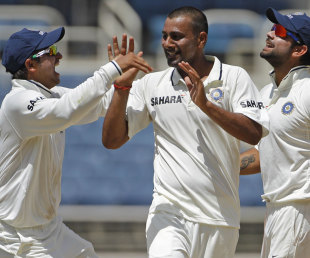India 246 (Raina 82, Harbhajan 70, Edwards 4-56) and 252 (Dravid 112, Sammy 4-52, Bishoo 4-65) beatWest Indies 173 (Barath 64, Ishant 3-29) and 262 (Praveen 3-42) by 63 runs
Scorecard and ball-by-ball details
How they were out
| 
| Praveen Kumar's two strikes on the fourth morning put India on course for a win © Associated Press |
| Enlarge |
|
|
In another demonstration of their improving record overseas, a weakened India eased to only their fifth Test win in the Caribbean. The resistance from West Indies was disappointingly limp at Sabina Park as they lost six of the seven remaining wickets in the morning session. Praveen Kumar, sporting a buzz cut, snapped the home side's resolve by removing both overnight batsmen, Darren Bravo and Shivnarine Chanderpaul, in the first half hour. There were some big hits from Darren Sammy and Ravi Rampaul, but they merely delayed an Indian victory.
The resolve the West Indian batsmen showed on the third evening didn't make an appearance on Thursday. The Indian bowlers weren't particularly threatening early on, regularly providing harmless leg-side deliveries. One of those broke the stand that had frustrated India for nearly two hours, with Bravo losing his leg stump after walking across to try and guide the ball to fine leg. In Praveen's next over, he had Chanderpaul chipping a catch to cover as the ball, after causing a cloud of dust on pitching, came on slower than the batsman expected.
West Indies' chances evaporated with those two strikes, and Harbhajan Singh made it worse, removing birthday boy Carlton Baugh for a duck. Sammy wasn't going to give up, though. He was struck on the forearm by a kicker from Harbhajan, which prompted him to attack. Some blacksmith-swings sent the final three deliveries of the over for leg-side sixes, with the last two flying into the second tier at least. The entertainment ended with Amit Mishra's first delivery, a tossed-up, over-pitched ball that Sammy wanted to send out of the ground but sent only as far as extra cover.
Brendan Nash, the vice-captain who has been desperately short of runs over the home summer, restricted himself to defensive nudges. When he attempted one of his first enterprising strokes, a pull off a short ball from Mishra, he was horrified to see the ball scoot through impossibly low to be trapped plumb lbw.
Ravi Rampaul gave the few fans that turned up something to cheer about with a series of swept and driven boundaries, the highlight of which was an inside-out six over extra cover off Harbhajan. Like Nash, he too was done in by a ball of unpredictable bounce, from Ishant: it took off from a length and had him gloving it to MS Dhoni, who leapt acrobatically to take a one-handed catch over his head.
The last pair kept out the final seven deliveries before lunch, and then kept India waiting for half an hour after the break. With the specialists unable to finish things off, Dhoni turned to the part-time offspin of Suresh Raina, who needed only two deliveries to bowl Bishoo and secure a 1-0 series lead.













